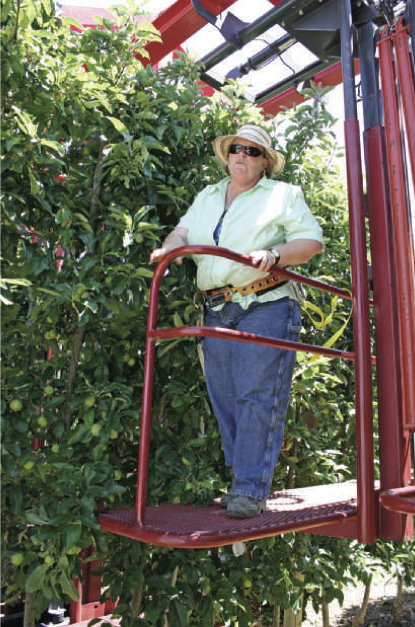
Karen Lewis tries out a new multirow orchard platform.
A new working group in the Pacific Northwest aims to promote the development of engineering solutions for specialty crops. Dr. Clark Seavert, director of Oregon State University’s North Willamette Research and Extension Center, who is chair of the group, said that with increasing concerns about labor availability and escalating production costs, growers are looking seriously at technology and engineering for solutions.
The group formed as a result of a workshop held in Kennewick, Washington, this summer that brought together state and federal researchers, extension educators, technology manufacturers and providers, and growers of tree fruits, grapes, hops, nuts, vegetables, and nursery trees.
One of its aims is to promote communication between the sectors involved and avoid duplication of effort. Seavert said he’d like to see a regional effort by the land-grant universities in the Northwest to provide resources for a communication specialist who would act as a liaison between growers, universities, and technology providers.
He also feels it will be important to evaluate the costs and benefits of new technologies, particularly in high-input, high-output crops like tree fruits. Seavert has developed a computer program called A Grower’s Technologies Economic Assessment Model (TEAM) to help growers evaluate the economic impacts.
Important industries
Washington State University Extension educator Karen Lewis, who is a member of the new working group, said its forma- tion is timely. Specialty crops account for 52 percent of the nation’s agricultural production and are finally being recognized at the federal level as an important group of industries that are providing healthy food to citizens. The current Farm Bill included a research initiative for specialty crops.
“People have been making a case for specialty crops for a lot of years, and it really came to fruition this year in the Farm Bill,” Lewis said.
The Tree Fruit Technology Road Map, initiated in Washington in 2001, went on to become national in scope, and a national working group has been meeting to discuss engineering solutions for specialty crops. Lewis said that while there are differences in how the various specialty crops are produced, particularly between perennial and annual crops, it’s important to find the commonalities in order to build stronger coalitions and leverage more research dollars.
“I think it’s important for lots of rea- sons—political, economic, etc.—that we have an avenue that represents us as one,” she said.
Possible labor shortages and increas- ing costs are two of the most urgent problems that need to be addressed in labor-intensive agriculture, she said, but there’s also a need to focus on tech- nologies that can provide information and guide management decisions to enable growers to supply a high-quality, efficiently produced product for the consumer.
Lewis envisions that specific road maps and position papers will be developed to articulate the challenges of each crop. She stressed that engineering solutions are not limited to new equipment, such as sprayer technology, but might also include sensors, information technology, decision support systems, and genetics and genomics projects leading to new plant material, for example.
“It’s really important to recognize that engineering solutions will come in many forms,” she said.
Orchardists at the workshop expressed concern that in order to adopt new tech- nologies they would have to convert all their acreage to modern systems, which would be prohibitively expensive. But Lewis said a multiprong approach is needed that will involve developing technology to augment workers and increase efficiency in traditional three- dimensional plantings, as well as technology that will improve the efficient production of premium•fruit in modern fruit-wall systems.




Leave A Comment